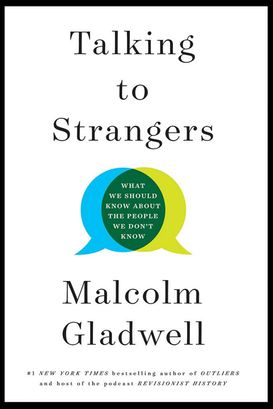Malcolm Gladwell delivers again with a spectacular new book

As an author of five previous bestselling books and the host of a stupendous podcast, Malcolm Gladwell has gained an impressive and well-deserved reputation. When his new book, Talking to Strangers, was published in 2019, there was bound to be high expectations for it.
We were not disappointed. With yet another knock out of the park, Gladwell proves to be one of the best non-fiction writers out there, giving us lessons about our world and society with his wit and classic method of storytelling. Just like all of Gladwell’s work, it’s not only a fantastic read, but teaches you essential things about the world you inhabit, lessons that will change the way you look at the world.
Talking to Strangers begins, as all Gladwell books do, with a story. It’s a story we’ve unfortunately heard too often these days: a police officer, Brian Encinia, pulls over an African American, Sandra Bland, on the highway. The stop was for failing to signal a lane change. Tensions escalate in the stop, and Encina eventually arrests Bland. Bland would commit suicice three days later in jail. While many people think they understand what happened, Gladwell wants to make sense of this interaction. How did a pull over for a failure to signal result in an arrest? How did it escalate? And what can this teach us about our own interactions with people we don’t know? Gladwell’s entire book tries to answer these questions and reveals deep truths about how we interact with strangers.
One of Gladwell’s greatest strengths is his impeccable use of stories interwoven with his research. All of his chapters begin not with facts, but with stories. Intriguing stories, ones that draw you into the chapter. For example, here’s the first paragraph of Chapter One:
“Florentino Aspillaga’s final posting was in Bratislava, in what was then Czechoslovakia. It was
1987, two years before the Iron Curtain fell. Aspillaga ran a consulting company called Cuba
Tecnica, which was supposed to have something to do with trade. It did not. It was a front.
Aspillaga was a high-ranking officer in Cuba’s General Directorate of Intelligence.”
Rather than beginning with erudite facts, Gladwell masterfully realizes that we humans love personal stories, and uses that to great effect throughout his book. Every chapter is underpinned by a case study, a story that perfectly encapsulates what that chapter is about. Not only do the stories themselves entertain, they allow Gladwell to seamlessly blend personal stories with scientific research, creating a perfect nugget that sticks in your brain even after the chapter is finished.
After the introductory story for each chapter, Gladwell digs deep into the scientific research that the story represents, and does so wonderfully. Each bit of information Gladwell teaches you is explained well, and makes tons of sense. This explanation isn’t dry, however; quite the contrary, Gladwell’s breezy and conversational writing style makes the information easily digestible, entertaining and sparks thoughts and connections in your mind. Everything Gladwell talks about is perfectly proven by the facts he gives, and never feels unproven or unfinished. Every premise that leads to his conclusions are deftly and easily explained without bogging down the chapter.
Research for Gladwell isn’t just about scouring books and articles, however. Much of how he delivers knowledge is through his own interviews of sources. Being a journalist, Gladwell does well at weaving in interviews with his writings, but Gladwell does more than that. Gladwell often describes the physical appearance and mannerisms of who he interviewed to give you something to imagine. It’s a tactic that’s employed all the time in fiction, but rarely in non-fiction; Gladwell uses it to full effect. The interviews enrich the chapters thoroughly, giving you a deeper sense of where his information came from.
How he presents the interviews also enhances them: rather than using “he said, she said”, he’ll often insert part the transcript of the interview, like this:
“MG: So describe what it was like.
Mitchell: You ever been on a super tall building and thought you might jump off? Knowing you wouldn’t jump off, but thought you might jump off? That’s what it felt like to me. I didn’t feel like I was going to die, I felt like I was afraid I was going to die.”
By not letting dialogue get bogged down by dialogue indicators, the words flow more smoothly and they provide a much bigger impact, as you probably understood from the quote above. Gladwell uses this style not just for interviews, but for audio clips, news interviews, court transcripts and more. All of it perfectly done for the words to pack a bigger punch.
After showing us the meat of the chapter, Gladwell returns to the main story and directly connects what we just learned to it, giving the chapter a circular and completed feel. Some nonfiction books simply drop off after the end of a chapter and don’t give too satisfying a conclusion. Every Gladwell chapter feels like a diamond of information perfectly wrapped in a blanket of story, making each chapter feel satisfying and complete.
I hope you are not getting the feeling that the chapters of Talking to Strangers are in any way formulaic. This couldn’t be further from the truth. The structure of chapters doesn’t distract from the book, but seamlessly enhances it, so much so that you don’t much notice it happening.
Not only does each chapter feel complete, the entire book feels complete. Every chapter feeds into the others, with later chapters referencing lessons from previous ones in such a way that the entire book feels connected, whole and beautifully harmonious. If each chapter is an instrument, several parts working together to play a glorious note, then the book is the orchestra, and succeeds in creating a beautiful piece of music.
Talking to Strangers feels complete for another important reason: it follows the same structure as the individual chapters. We’ve already noted how the book begins with a story: information is presented in the intervening chapters then, in the final chapter, Gladwell returns to the original story and uses everything we’ve learned to shed light on what happened that day. Once again, this gives the book, just like each chapter, a glorious sense of completeness, and leaves you feeling satisfied by the end. Everything feels like it connects, and everything in the book feels like it had a purpose. After closing the book, I got a sense that I had learned so much, and I hadn’t really noticed it. Everything flowed together and connected together so well.
I almost can’t recommend this book enough. Not only is it a great read and masterfully written, but it will also impart to you lessons about our interactions with others, lessons you will likely think about long after the book is closed.

Zane Emerson is a senior, and loves writing stories about politics, books, or whatever he’s interested in at the moment. People describe him as funny, competitive, and a nerd. He loves being a journalist because he has the freedom to explore interesting ideas and share them with the world. When he’s not writing a story, he likes to play board games, watch football (Go Seahawks!), and spend time...






